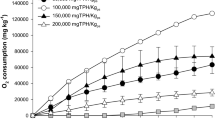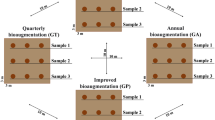Abstract
Purpose
The desorption behaviour of 16 polycyclic aromatic hydrocarbons (PAHs) in sludges from two sites of the port of Rotterdam, The Netherlands, which are designated to be stored in a subaqueous sludge depository, was investigated after a storage time of 14 years at 4 °C under anaerobic conditions in the dark, mimicking depository conditions. Such long-term storage is believed to effect the desorption of the PAHs.
Materials and methods
Batch desorption experiments over a time period of 130 days were performed with the brackish Beerkanaal (BK) sludge and the freshwater Beneden Merwede River (BMR) sludge. The organic carbon–water partitioning coefficient (K OC) values were calculated and compared to values of a previous study on the same sludges after a storage time of 3 years and to values obtained from calculations based on octanol–water partitioning coefficient (K OW) values. Additionally, the organic matter of the sludges was characterised by C and N elemental analysis and solid-state 13C nuclear magnetic resonance spectroscopy.
Results and discussion
Only desorption of low molecular weight PAHs up to pyrene was detected. Several K OC values were higher compared to the values from the previous study, and all were increased compared to values based on K OW values. It is assumed that the increase in K OC was an effect of the prolonged contact time, causing slow intradomain diffusion of PAHs into the condensed carbon domains. Desorption was higher in BK than in BMR, which is explained by differences in organic matter composition because BMR (containing predominantly aromatic carbon) and BK (which was dominated by lipids) contained the same amount of organic carbon. It is inferred that lipids compete with PAHs for sorption sites on the aromatic carbon, so that lipids block these sorption sites, and the PAHs are adsorbed to the lipids.
Conclusions
Since the amounts of PAHs desorbed from both sludges in this study were so low, it is supposed that long-term storage of these sludges in subaqueous depositories will likely result in increased sorption and thus a reduced release of these contaminants into the environment over time.



Similar content being viewed by others
References
Accardi-Dey A, Gschwend PM (2002) Assessing the combined roles of natural organic matter and black carbon as sorbents in sediments. Environ Sci Tech 36:21–29
Ahangar AG, Smernik RJ, Kookana RS, Chittleborough DJ (2009) The effect of lipids on the sorption of diuron and phenanthrene in soils. Chemosphere 74:1062–1068
Baldock JA, Oades JM, Nelson PN, Skene TM, Golchin A, Clarke P (1997) Assessing the extent of decomposition of natural organic materials using solid-state 13C NMR spectroscopy. Aust J Soil Res 35:1061–1083
Bohn HL, McNeal BL, O’Connor GA (2001) Soil Chemistry. John Wiley, New York
Chen D, Xing B, Xie W (2007) Sorption of phenanthrene, naphthalene and o-xylene by soil organic matter fractions. Geoderma 139:329–335
Chladek E, Marano RS (1984) Use of bonded phase silica sorbents for the sampling of priority pollutants in wastewaters. J Chromatogr Sci 22:313–320
Cornelissen G, Gustafsson Ö, Bucheli TD, Jonker MTO, Koelmans AA, van Noort PCM (2005) Extensive sorption of organic compounds to black carbon, coal, and kerogen in sediments and soils: mechanisms and consequences for distribution, bioaccumulation, and biodegradation. Environ Sci Tech 39:6881–6895
De Paolis F, Kukkonen J (1997) Binding of organic pollutants to humic and fulvic acids: influence of pH and the structure of humic material. Chemosphere 34:1693–1704
Ertel JR, Hedges JI (1983) Bulk chemical and spectroscopic properties of marine and terrestrial humic acids, melanoidins and catechol-based synthetic polymers. In: Christman RF, Gjessing ET (eds) Aquatic and Terrestrial Humic Materials. Ann Arbor Science, Michigan, USA, pp 143–163
Grathwohl P (1990) Influence of organic matter from soils and sediments from various origins on the sorption of some chlorinated aliphatic hydrocarbons: implications on KOC correlations. Environ Sci Tech 24:1687–1693
Hartmann R (1996) Polycyclic aromatic hydrocarbons (PAHs) in forest soils: critical evaluation of a new analytical procedure. Int J Environ Anal Chem 62:161–173
Jonker MTO, Koelmans AA (2002) Sorption of polycyclic aromatic hydrocarbons and polychlorinated biphenyls to soot and soot-like materials in the aqueous environment: mechanistic considerations. Environ Sci Tech 36:3725–3734
Kang S, Xing B (2005) Phenanthrene sorption to sequentially extracted soil humic acids and humins. Environ Sci Tech 39:134–140
Karickhoff SW, Brown DS, Scott TA (1979) Sorption of hydrophobic pollutants on natural sediments. Water Res 13:241–248
Keijzer TJS, Middeldorp PF, van Alphen M, van der Linde PR, Loch JPG (2002) Desorption behaviour of polycyclic aromatic hydrocarbons in harbour sludge form the Port of Rotterdam, the Netherlands. Water Air Soil Pollut 136:361–385
Kleineidam S, Rügner H, Ligouis B, Grathwohl P (1999) Organic matter facies and equilibrium sorption of phenanthrene. Environ Sci Tech 33:1637–1644
Knicker H, González-Vila FJ, Polvillo O, Gonzáles JA, Almendros G (2005) Fire-induced transformation of C- and N-forms in different organic soil fractions from a Dystric Cambisol under a Mediterranean pine forest (Pinus pinaster). Soil Biol Biochem 37:701–718
Kögel-Knabner I (2002) The macromolecular organic composition of plant and microbial residues as inputs to soil organic matter. Soil Biol Biochem 34:139–162
Kohl SD, Rice JA (1999) Contribution of lipids to the nonlinear sorption of polycyclic aromatic hydrocarbons to soil organic matter. Org Geochem 30:929–936
Ku H-W, Chen Y-G, Chan P-S, Liu H-C, Lin C-C (2007) Paleo-environmental evolution as revealed by analysis of organic carbon and nitrogen: a case of coastal Taipei Basin in Northern Taiwan. Geochem J 41:111–120
Meyers PA (1994) Preservation of elemental and isotopic source identification of sedimentary organic matter. Chem Geol 114:289–302
Middelburg JJ, Nieuwenhuize J (1998) Carbon and nitrogen stable isotopes in suspended matter and sediments from the Schelde Estuary. Mar Chem 60:217–225
Perminova IV, Grechishcheva NY, Petrosyan VS (1999) Relationships between structure and binding affinity of humic substances for polycyclic aromatic hydrocarbons: relevance of molecular descriptors. Environ Sci Tech 33:3781–3787
Prahl FG, Bennett JT, Carpenter R (1980) The early diagenesis of aliphatic hydrocarbons and organic matter in sedimentary particulates from Dabob Bay, Washington. Geochim Cosmochim Acta 44:1967–1976
Quantin C, Joner EJ, Portal JM, Berthelin J (2005) PAH dissipation in a contaminated river sediment under oxic and anoxic conditions. Environ Pollut 134:315–322
Quideau SA, Anderson MA, Graham RC, Chadwick OA, Trumbore SE (2000) Soil organic matter processes: characterization by 13C NMR and 14C measurements. Forest Ecol Manag 138:19–27
Rothermich MM, Hayes LA, Lovley DR (2002) Anaerobic, sulfate-dependent degradation of polycyclic aromatic hydrocarbons in petroleum-contaminated harbor sediment. Environ Sci Tech 36:4811–4817
Schaanning M, Beryholtz B, Skei J (2006) Experimental results on effects of capping on fluxes of persistent organic pollutants (POPs) from historically contaminated sediments. Mar Chem 102:46–59
Schwarzenbach RP, Gschwend PM, Imboden DM (1993) Environmental Organic Chemistry. John Wiley, New York
Sims RC, Overcash MR (1983) Fate of polynuclear aromatic compounds (PNAs) in soil-plant systems. Residue Rev 88:1–68
Sposito G (1989) The Chemistry of Soils. Oxford University Press, New York
Thimdee W, Deein G, Sangrungruang C, Nishioka J, Matsunaga K (2003) Sources and fate of organic matter in Khung Krabaen Bay (Thailand) as traced by δ13C and C/N atomic ratios. Wetlands 23:729–738
Tremblay L, Kohl SD, Rice JA, Gagné J-P (2005) Effect of lipids on the sorption of hydrophobic organic compounds on geosorbents: a case study using phenanthrene. Chemosphere 58:1609–1620
Weber WJ Jr, Huang W (1996) A distributed reactivity model for sorption by soils and sediments. 4. Intraparticle heterogeneity and phase-distribution relationships under nonequilibrium conditions. Environ Sci Tech 30:881–888
Wen B, Zhang J-J, Zhang S-Z, Shan X-Q, Khan SU, Xing B (2007) Phenanthrene sorption to soil humic acid and different humin fractions. Environ Sci Tech 41:3165–3171
Acknowledgments
We thank Bärbel Angres (Technische Universität München) for technical assistance. Sabine Pols acknowledges an Erasmus-placement grant for her stay in Freising-Weihenstephan. Tom Bosma was partially supported by the King Abdullah University of Science and Technology (KAUST) in the framework of the SOWACOR Centre in Development at Utrecht University (grant no. KUK-C1-017-12). We thank the submission editor and three anonymous reviewers for their helpful comments to improve the manuscript.
Author information
Authors and Affiliations
Corresponding author
Additional information
Responsible editor: Trudy J. Estes
Electronic supplementary material
Below is the link to the electronic supplementary material.
ESM 1
(PDF 190 kb)
Rights and permissions
About this article
Cite this article
Heister, K., Pols, S., Loch, J.P.G. et al. Desorption behaviour of polycyclic aromatic hydrocarbons after long-term storage of two harbour sludges from the port of Rotterdam, The Netherlands. J Soils Sediments 13, 1113–1122 (2013). https://doi.org/10.1007/s11368-013-0689-z
Received:
Accepted:
Published:
Issue Date:
DOI: https://doi.org/10.1007/s11368-013-0689-z




